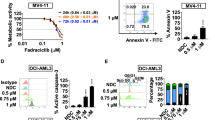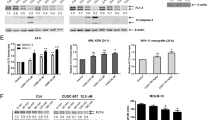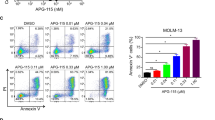Abstract
In acute myeloid leukemia (AML), several signaling pathways such as the phosphatidylinositol-3-kinase/AKT and the mammalian target of rapamycin (PI3K/AKT/mTOR) pathway are deregulated and constitutively activated as a consequence of genetic and cytogenetic abnormalities. We tested the effectiveness of PI3K/AKT/mTOR-targeting therapies and tried to identify alterations that associate with treatment sensitivity. By analyzing primary samples and cell lines, we observed a wide range of cytotoxic activity for inhibition of AKT (MK-2206), mTORC1 (rapamycin) and PI3K/mTORC1/2 (BEZ-235) with a high sensitivity of cells carrying an MLL rearrangement. In vivo PI3K/mTOR inhibition delayed tumor progression, reduced tumor load and prolonged survival in an MLL-AF9+/FLT3-ITD+ xenograft mouse model. By performing targeted amplicon sequencing in 38 MLL-AF9+ and 125 cytogenetically normal AML patient samples, we found a high additional mutation rate for genes involved in growth factor signaling in 79% of all MLL-AF9+ samples, which could lead to a possible benefit of this cohort. PI3K/mTOR inhibition for 24 h led to the cross-activation of the ERK pathway. Further in vitro studies combining PI3K/mTOR and ERK pathway inhibition revealed highly synergistic effects in apoptosis assays. Our data implicate a possible therapeutic benefit of PI3K/mTOR inhibition in the MLL-mutated subgroup. Inhibiting rescue pathways could improve the therapeutic efficacy of PI3K-targeted therapies in AML.
This is a preview of subscription content, access via your institution
Access options
Subscribe to this journal
Receive 12 print issues and online access
$259.00 per year
only $21.58 per issue
Buy this article
- Purchase on Springer Link
- Instant access to full article PDF
Prices may be subject to local taxes which are calculated during checkout







Similar content being viewed by others
References
Steffen B, Muller-Tidow C, Schwable J, Berdel WE, Serve H . The molecular pathogenesis of acute myeloid leukemia. Crit Rev Oncol/Hematol 2005; 56: 195–221.
Grandage VL, Gale RE, Linch DC, Khwaja A . PI3-kinase/Akt is constitutively active in primary acute myeloid leukaemia cells and regulates survival and chemoresistance via NF-kappaB, Mapkinase and p53 pathways. Leukemia 2005; 19: 586–594.
Min YH, Eom JI, Cheong JW, Maeng HO, Kim JY, Jeung HK et al. Constitutive phosphorylation of Akt/PKB protein in acute myeloid leukemia: its significance as a prognostic variable. Leukemia 2003; 17: 995–997.
Kornblau SM, Tibes R, Qiu YH, Chen W, Kantarjian HM, Andreeff M et al. Functional proteomic profiling of AML predicts response and survival. Blood 2009; 113: 154–164.
Min YH, Cheong JW, Kim JY, Eom JI, Lee ST, Hahn JS et al. Cytoplasmic mislocalization of p27Kip1 protein is associated with constitutive phosphorylation of Akt or protein kinase B and poor prognosis in acute myelogenous leukemia. Cancer Res 2004; 64: 5225–5231.
Cheong JW, Eom JI, Maeng HY, Lee ST, Hahn JS, Ko YW et al. Phosphatase and tensin homologue phosphorylation in the C-terminal regulatory domain is frequently observed in acute myeloid leukaemia and associated with poor clinical outcome. Br J Haematol 2003; 122: 454–456.
Muranyi AL, Dedhar S, Hogge DE . Combined inhibition of integrin linked kinase and FMS-like tyrosine kinase 3 is cytotoxic to acute myeloid leukemia progenitor cells. Exp Hematol 2009; 37: 450–460.
Birkenkamp KU, Geugien M, Schepers H, Westra J, Lemmink HH, Vellenga E . Constitutive NF-kappaB DNA-binding activity in AML is frequently mediated by a Ras/PI3-K/PKB-dependent pathway. Leukemia 2004; 18: 103–112.
Yilmaz OH, Valdez R, Theisen BK, Guo W, Ferguson DO, Wu H et al. Pten dependence distinguishes haematopoietic stem cells from leukaemia-initiating cells. Nature 2006; 441: 475–482.
Zhang J, Grindley JC, Yin T, Jayasinghe S, He XC, Ross JT et al. PTEN maintains haematopoietic stem cells and acts in lineage choice and leukaemia prevention. Nature 2006; 441: 518–522.
Sheppard K, Kinross KM, Solomon B, Pearson RB, Phillips WA . Targeting PI3 kinase/AKT/mTOR signaling in cancer. Crit Rev Oncogen 2012; 17: 69–95.
Stapnes C, Gjertsen BT, Reikvam H, Bruserud O . Targeted therapy in acute myeloid leukaemia: current status and future directions. Exp Opin Invest Drugs 2009; 18: 433–455.
Bacher U, Haferlach C, Kern W, Haferlach T, Schnittger S . Prognostic relevance of FLT3-TKD mutations in AML: the combination matters—an analysis of 3082 patients. Blood 2008; 111: 2527–2537.
Schnittger S, Kinkelin U, Schoch C, Heinecke A, Haase D, Haferlach T et al. Screening for MLL tandem duplication in 387 unselected patients with AML identify a prognostically unfavorable subset of AML. Leukemia 2000; 14: 796–804.
Schnittger S, Schoch C, Dugas M, Kern W, Staib P, Wuchter C et al. Analysis of FLT3 length mutations in 1003 patients with acute myeloid leukemia: correlation to cytogenetics, FAB subtype, and prognosis in the AMLCG study and usefulness as a marker for the detection of minimal residual disease. Blood 2002; 100: 59–66.
Schnittger S, Schoch C, Kern W, Mecucci C, Tschulik C, Martelli MF et al. Nucleophosmin gene mutations are predictors of favorable prognosis in acute myelogenous leukemia with a normal karyotype. Blood 2005; 106: 3733–3739.
Placke T, Faber K, Nonami A, Putwain SL, Salih HR, Heidel FH et al. Requirement for CDK6 in MLL-rearranged acute myeloid leukemia. Blood 2014; 124: 13–23.
Li H, Durbin R . Fast and accurate short read alignment with Burrows–Wheeler transform. Bioinformatics 2009; 25: 1754–1760.
Koboldt DC, Zhang Q, Larson DE, Shen D, McLellan MD, Lin L et al. VarScan 2: somatic mutation and copy number alteration discovery in cancer by exome sequencing. Genome Res 2012; 22: 568–576.
Ye K, Schulz MH, Long Q, Apweiler R, Ning Z . Pindel: a pattern growth approach to detect break points of large deletions and medium sized insertions from paired-end short reads. Bioinformatics 2009; 25: 2865–2871.
Rabinovich BA, Ye Y, Etto T, Chen JQ, Levitsky HI, Overwijk WW et al. Visualizing fewer than 10 mouse T cells with an enhanced firefly luciferase in immunocompetent mouse models of cancer. Proc Natl Acad Sci USA 2008; 105: 14342–14346.
Terziyska N, Castro Alves C, Groiss V, Schneider K, Farkasova K, Ogris M et al. In vivo imaging enables high resolution preclinical trials on patients' leukemia cells growing in mice. PLoS One 2012; 7: e52798.
Polzer H, Janke H, Schmid D, Hiddemann W, Spiekermann K . Casitas B-lineage lymphoma mutants activate AKT to induce transformation in cooperation with class III receptor tyrosine kinases. Exp Hematol 2013; 41: 271–80 e4.
Ehrhardt H, Schrembs D, Moritz C, Wachter F, Haldar S, Graubner U et al. Optimized anti-tumor effects of anthracyclines plus Vinca alkaloids using a novel, mechanism-based application schedule. Blood 2011; 118: 6123–6131.
Krupka C, Kufer P, Kischel R, Zugmaier G, Bogeholz J, Kohnke T et al. CD33 target validation and sustained depletion of AML blasts in long-term cultures by the bispecific T-cell-engaging antibody AMG 330. Blood 2014; 123: 356–365.
Reikvam H, Olsnes AM, Gjertsen BT, Ersvar E, Bruserud O . Nuclear factor-kappaB Signaling: a contributor in leukemogenesis and a target for pharmacological intervention in human acute myelogenous leukemia. Crit Rev Oncogen 2009; 15: 1–36.
Minke KS, Staib P, Puetter A, Gehrke I, Gandhirajan RK, Schlosser A et al. Small molecule inhibitors of WNT signaling effectively induce apoptosis in acute myeloid leukemia cells. Eur J Haematol 2009; 82: 165–175.
Ghoshal GS, Baumann H, Wetzler M . Epigenetic regulation of signal transducer and activator of transcription 3 in acute myeloid leukemia. Leukemia Res 2008; 32: 1005–1014.
Martelli AM, Tazzari PL, Evangelisti C, Chiarini F, Blalock WL, Billi AM et al. Targeting the phosphatidylinositol 3-kinase/Akt/mammalian target of rapamycin module for acute myelogenous leukemia therapy: from bench to bedside. Curr Med Chem 2007; 14: 2009–2023.
Xu Q, Simpson SE, Scialla TJ, Bagg A, Carroll M . Survival of acute myeloid leukemia cells requires PI3 kinase activation. Blood 2003; 102: 972–980.
Carpten JD, Faber AL, Horn C, Donoho GP, Briggs SL, Robbins CM et al. A transforming mutation in the pleckstrin homology domain of AKT1 in cancer. Nature 2007; 448: 439–444.
Kang S, Bader AG, Vogt PK . Phosphatidylinositol 3-kinase mutations identified in human cancer are oncogenic. Proc Natl Acad Sci USA 2005; 102: 802–807.
Tamburini J, Chapuis N, Bardet V, Park S, Sujobert P, Willems L et al. Mammalian target of rapamycin (mTOR) inhibition activates phosphatidylinositol 3-kinase/Akt by up-regulating insulin-like growth factor-1 receptor signaling in acute myeloid leukemia: rationale for therapeutic inhibition of both pathways. Blood 2008; 111: 379–382.
Chandarlapaty S, Sawai A, Scaltriti M, Rodrik-Outmezguine V, Grbovic-Huezo O, Serra V et al. AKT inhibition relieves feedback suppression of receptor tyrosine kinase expression and activity. Cancer cell 2011; 19: 58–71.
Jacinto E, Loewith R, Schmidt A, Lin S, Ruegg MA, Hall A et al. Mammalian TOR complex 2 controls the actin cytoskeleton and is rapamycin insensitive. Nat Cell Biol 2004; 6: 1122–1128.
Tamburini J, Green AS, Bardet V, Chapuis N, Park S, Willems L et al. Protein synthesis is resistant to rapamycin and constitutes a promising therapeutic target in acute myeloid leukemia. Blood 2009; 114: 1618–1627.
Roux PP, Shahbazian D, Vu H, Holz MK, Cohen MS, Taunton J et al. RAS/ERK signaling promotes site-specific ribosomal protein S6 phosphorylation via RSK and stimulates cap-dependent translation. J Biol Chem 2007; 282: 14056–14064.
Wiesner FG, Magener A, Fasching PA, Wesse J, Bani MR, Rauh C et al. Ki-67 as a prognostic molecular marker in routine clinical use in breast cancer patients. Breast 2009; 18: 135–141.
Yamamoto S, Ibusuki M, Yamamoto Y, Fu P, Fujiwara S, Murakami K et al. Clinical relevance of Ki67 gene expression analysis using formalin-fixed paraffin-embedded breast cancer specimens. Breast Cancer 2013; 20: 262–270.
Kuo HP, Wang Z, Lee DF, Iwasaki M, Duque-Afonso J, Wong SH et al. Epigenetic roles of MLL oncoproteins are dependent on NF-kappaB. Cancer Cell 2013; 24: 423–437.
Kampen KR, Ter Elst A, Mahmud H, Scherpen FJ, Diks SH, Peppelenbosch MP et al. Insights in dynamic kinome reprogramming as a consequence of MEK inhibition in MLL-rearranged AML. Leukemia 2014; 28: 589–599.
Yoshimi A, Goyama S, Watanabe-Okochi N, Yoshiki Y, Nannya Y, Nitta E et al. Evi1 represses PTEN expression and activates PI3K/AKT/mTOR via interactions with polycomb proteins. Blood 2011; 117: 3617–3628.
Lugthart S, van Drunen E, van Norden Y, van Hoven A, Erpelinck CA, Valk PJ et al. High EVI1 levels predict adverse outcome in acute myeloid leukemia: prevalence of EVI1 overexpression and chromosome 3q26 abnormalities underestimated. Blood 2008; 111: 4329–4337.
Ho PA, Alonzo TA, Gerbing RB, Pollard JA, Hirsch B, Raimondi SC et al. High EVI1 expression is associated with MLL rearrangements and predicts decreased survival in paediatric acute myeloid leukaemia: a report from the children's oncology group. Br J Haematol 2013; 162: 670–677.
Grossmann V, Schnittger S, Poetzinger F, Kohlmann A, Stiel A, Eder C et al. High incidence of RAS signalling pathway mutations in MLL-rearranged acute myeloid leukemia. Leukemia 2013; 27: 1933–1936.
Bacher U, Haferlach T, Schoch C, Kern W, Schnittger S . Implications of NRAS mutations in AML: a study of 2502 patients. Blood 2006; 107: 3847–3853.
Bowen DT, Frew ME, Hills R, Gale RE, Wheatley K, Groves MJ et al. RAS mutation in acute myeloid leukemia is associated with distinct cytogenetic subgroups but does not influence outcome in patients younger than 60 years. Blood 2005; 106: 2113–2119.
Castellano E, Downward J . Role of RAS in the regulation of PI 3-kinase. Curr Top Microbiol Immunol 2010; 346: 143–169.
Chapuis N, Tamburini J, Green AS, Vignon C, Bardet V, Neyret A et al. Dual inhibition of PI3K and mTORC1/2 signaling by NVP-BEZ235 as a new therapeutic strategy for acute myeloid leukemia. Clin Cancer Res 2010; 16: 5424–5435.
Cao P, Maira SM, Garcia-Echeverria C, Hedley DW . Activity of a novel, dual PI3-kinase/mTor inhibitor NVP-BEZ235 against primary human pancreatic cancers grown as orthotopic xenografts. Br J Cancer 2009; 100: 1267–1276.
Li Z, Yan S, Attayan N, Ramalingam S, Thiele CJ . Combination of an allosteric Akt Inhibitor MK-2206 with etoposide or rapamycin enhances the antitumor growth effect in neuroblastoma. Clin Cancer Res 2012; 18: 3603–3615.
Maira SM, Stauffer F, Brueggen J, Furet P, Schnell C, Fritsch C et al. Identification and characterization of NVP-BEZ235, a new orally available dual phosphatidylinositol 3-kinase/mammalian target of rapamycin inhibitor with potent in vivo antitumor activity. Mol Cancer Therap 2008; 7: 1851–1863.
Kim S, Dodd RD, Mito JK, Ma Y, Kim Y, Riedel RF et al. Efficacy of phosphatidylinositol-3 kinase inhibitors in a primary mouse model of undifferentiated pleomorphic sarcoma. Sarcoma 2012; 2012: 680708.
Engelman JA, Chen L, Tan X, Crosby K, Guimaraes AR, Upadhyay R et al. Effective use of PI3K and MEK inhibitors to treat mutant Kras G12D and PIK3CA H1047R murine lung cancers. Nat Med 2008; 14: 1351–1356.
Zarrinkar PP, Gunawardane RN, Cramer MD, Gardner MF, Brigham D, Belli B et al. AC220 is a uniquely potent and selective inhibitor of FLT3 for the treatment of acute myeloid leukemia (AML). Blood 2009; 114: 2984–2992.
Levis MJ, Perl AE, Dombret H, Döhner H, Steffen B, Rousselot P et alFinal results of a phase 2 open-label, monotherapy efficacy and safety study of quizartinib (AC220) in patients with FLT3-ITD positive or negative relapsed/refractory acute myeloid leukemia after second-line chemotherapy or hematopoietic. Stem Cell Transplantation. 54th ASH Annual Meeting, 2012.
Altman JK, Foran JM, Pratz KW, Trone D, Gammon G, Cortes JE et alResults of a phase 1 study of quizartinib (AC220, ASP2689) in combination with induction and consolidation chemotherapy in younger patients with newly diagnosed acute myeloid leukemia. 55th ASH Annual Meeting, 2013; abstract 623.
Serra V, Scaltriti M, Prudkin L, Eichhorn PJ, Ibrahim YH, Chandarlapaty S et al. PI3K inhibition results in enhanced HER signaling and acquired ERK dependency in HER2-overexpressing breast cancer. Oncogene 2011; 30: 2547–2557.
Turke AB, Song Y, Costa C, Cook R, Arteaga CL, Asara JM et al. MEK inhibition leads to PI3K/AKT activation by relieving a negative feedback on ERBB receptors. Cancer Res 2012; 72: 3228–3237.
Britschgi A, Andraos R, Brinkhaus H, Klebba I, Romanet V, Muller U et al. JAK2/STAT5 inhibition circumvents resistance to PI3K/mTOR blockade: a rationale for cotargeting these pathways in metastatic breast cancer. Cancer Cell 2012; 22: 796–811.
Acknowledgements
We thank the participating centers of the AMLCG clinical trial, A Graupner for excellent technical assistance, B Vick for providing PDX cells, the staff of the animal facility and all members of the Laboratory for Leukemia Diagnostics at the University of Munich. This work was supported by Deutsche José Carreras Leukämie Stiftung and by the Collaborative Research Center 684, projects A12 and A22.
Author information
Authors and Affiliations
Corresponding author
Ethics declarations
Competing interests
The authors declare no conflict of interest.
Additional information
Supplementary Information accompanies this paper on the Leukemia website
Supplementary information
Rights and permissions
About this article
Cite this article
Sandhöfer, N., Metzeler, K., Rothenberg, M. et al. Dual PI3K/mTOR inhibition shows antileukemic activity in MLL-rearranged acute myeloid leukemia. Leukemia 29, 828–838 (2015). https://doi.org/10.1038/leu.2014.305
Received:
Revised:
Accepted:
Published:
Issue Date:
DOI: https://doi.org/10.1038/leu.2014.305
This article is cited by
-
Comparative performance of scFv-based anti-BCMA CAR formats for improved T cell therapy in multiple myeloma
Cancer Immunology, Immunotherapy (2024)
-
Programmable multispecific DNA-origami-based T-cell engagers
Nature Nanotechnology (2023)
-
HMGN1 plays a significant role in CRLF2 driven Down Syndrome leukemia and provides a potential therapeutic target in this high-risk cohort
Oncogene (2022)
-
Disassembly of α6β4-mediated hemidesmosomal adhesions promotes tumorigenesis in PTEN-negative prostate cancer by targeting plectin to focal adhesions
Oncogene (2022)
-
Small molecules in targeted cancer therapy: advances, challenges, and future perspectives
Signal Transduction and Targeted Therapy (2021)



